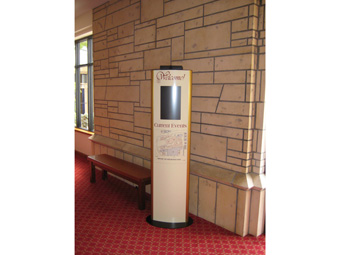 Digital signage has become an integral part of most signage project; This is greatly attributed to the following factors: the quality has increased, the technology has improved, the design has been made much more user-friendly, the cost has decreased, and the customers’ interest in the product has been growing rapidly.
Digital signage has become an integral part of most signage project; This is greatly attributed to the following factors: the quality has increased, the technology has improved, the design has been made much more user-friendly, the cost has decreased, and the customers’ interest in the product has been growing rapidly.
However it is important to keep in mind that digital signage, with its many merits and advantages, has yet to replace—and will most likely never replace—architectural and three-dimensional signs. It is safe to assume that an emergency exit pictogram will remain an emergency exit pictogram in ten years time. However, wherever you have a need for real time data (directions, menus, departures, schedule of lectures, sales, etc.), a digital sign might be just the right solution.
Sign shops should add a digital solution to their traditional signage program to meet the rising market demand, and it would be unwise for a sign shop owner to refrain from offering a product desired by the end-users. The name of the game has been (and always will be) catching the attention of customers and/or transferring information in an astatically and interactive manner.
There’s no question about it: Digital signage offers the highest level of message communication both dynamically and visually. In addition, the new advertising trend of out-of-home TV is on the rise and a clear trend of monitor (digital signs) placement is on the rise. For example, hairdressers utilize this technology to advertise their suppliers, neighboring businesses, and their own products; similarly a hardware store will have the digital sign present “how to” videos, supplier sponsorships, sales, and specials. And the list goes on.
The trick is to teach the sign professionals bidding on jobs, to add the digital solution to their offering, as most end-users are not even aware of how much they have to gain until we inform them.
My advice to a sign shop owner looking to make his or her first step into the digital arena would be to start off with a simple media player-based system. This option allows the user to upload the information they wish to display onto a memory chip. Once they have successfully entered the digital experience they could move onto remote or Internet-based systems. The latter of the two may require a bit more knowledge, experience and technical support, and that is why you should consider starting off with the simple digital version first.
 The technological know-how required to get started is minimal, if you decide to go with the media player-based option. This can be your diving board into the world of digital signs.
The technological know-how required to get started is minimal, if you decide to go with the media player-based option. This can be your diving board into the world of digital signs.
It is important to point out that the mishap rate may more than likely increase as you are using more elements in your signs than before. For this reason, I would like to stress the importance of working with a manufacturer who will support you when you are staring at your sign, scratching your head trying to figure out what to do. Chose a frame system manufacturer that will help you through the process—one who offers excellent service and who has the necessary experience. You may turn to sub-contractors in the digital field or consultants such as www.getmemo.com.
Choose a digital solution that is part of a system—it will make your life easier! Digital signs are an integral part of a sign project, and therefore a sign system that wishes to survive in these hard times must offer digital solutions as well.
Needless to say there are numerous advantages both for the end-user and the sign shop when using a single system for the entire project instead of zigzagging between vendors.
—Danny Schneider
Danny Schneider is vice-president of Sales & Business Development at Vista System. For more information, visit www.vistasystem.com.











